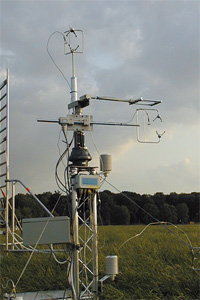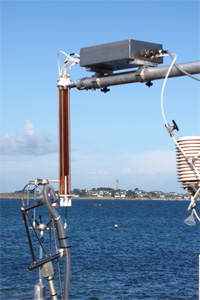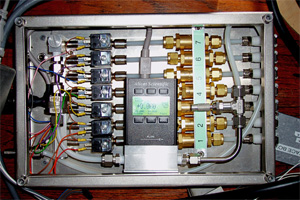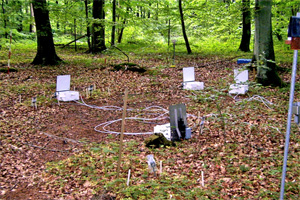Flux Measurement
There are a number of different techniques used to measure surface – atmosphere fluxes. These include Eddy Covariance and Relaxed Eddy Accumulation techniques which measure concentration differences between turbulent updrafts and downdrafts, Gradient techniques where concentrations are measured at multiple heights and Chambers where quantities of material emitted or deposited are measured in an isolated environment. The Centre for Atmospheric Sciences has utilised all of these techniques and is actively involved in developing measurement systems which rely on them.
Eddy Covariance Technique
For the Eddy Covariance Technique simultaneous high speed measurements are made of three dimensional wind speeds and the species in question. Concentration measurements in updrafts and downdrafts are averaged over the flux interval (typically 15 – 60 minutes), the flux is then determined from the difference between updraft and downdraft concentration and the micrometeorological conditions. These measurements need to be fast enough to resolve the turbulent eddies if fluxes are to be successfully measured, so the speed required increases with decreasing height. Time delays between wind speed and other measurements are accounted for by maximising correlation between the two during data processing. Typically 20Hz measurements are required at heights of 1-2m, while 1Hz measurements are sufficient at heights of 30m or so, though this is dependant on the roughness length of the fetch and the wind speed. While the speed of measurements required decreases with height, the required sensitivity increases because as eddies become larger concentration differences between updrafts and downdrafts are smaller. Additionally the fetch is much larger and may make interpretation of the measurements more difficult. In general Eddy Covariance is the preferred technique for flux measurements of species for which a suitable fast response sensor is available.
Within the Centre for Atmospheric Sciences this technique is widely used and development work has focussed on producing software to collect and process high speed measurements. This work makes use of the National Instruments Labview programming environment and we are currently able to measure fluxes of a wide variety of species using this technique. In most cases all data processing is done online, with calculated fluxes displayed within a second or so of the end of each flux interval. This online processing helps to considerably improve data quality as any malfunction of the system is quickly apparent. Currently fluxes of the following species can be measured using this technique: latent and sensible heat; ultra-fine, accumulation and coarse mode aerosol number; accumulation mode aerosol chemical species; ozone; oxides of nitrogen; ammonia; nitric acid; formaldehyde. Instruments used to make such measurements include ultrasonic anemometer (wind/turbulence/temperature), Krypton Hygrometer (water vapour), Condensation particle counter (ultra-fine and accumulation mode aerosol), optical particle counter (size resolved aerosol), Quantum cascade laser absorbtion spectrometer (ammonia/nitric acid/formaldehyde), chemical ionisation mass spectrometer (ammonia).
Relaxed Eddy Accumulation (REA) Flux Measurements
REA system for measurement of fluxes of molecular iodine from the coastal inter-tidal zone. Iodine is collected onto the inner starch coated surface of the brown glass tubes, which are then analysed after the project. The carousel pictured contains seven such tubes to provide updraft and downdraft measurements for three consecutive flux intervals and the seventh to sample the dead band for all three intervals.
Relaxed Eddy Accumulation is used to measure turbulent fluxes of species for which a fast response sensor is not available, thus making eddy covariance flux measurements impossible. This technique uses fast response measurements of 3d wind speed made with a sonic anemometer as for eddy covariance measurements. These wind measurements are processed in real time to allow a set of valves to be switched based on turbulent variations from the running mean vertical velocity. Thus eddies are conditionally sampled according to updrafts and downdrafts. Sampled air is then analysed using several parallel slow response detection systems (such as absorption or denuder tubes), or is stored in a reservoir for sequential sampling with a suitable detector. Often as well as updrafts and downdrafts a dead band where vertical velocity is close to the running mean is also defined. Air sampled from the dead band may be analysed, or discarded, as it is not required for flux calculation, but if analysed may improve the accuracy of absolute concentration measurements.
Within the Centre for Atmospheric Science this technique has been applied to flux measurements of aerosol chemical composition over urban areas, ammonia over grassland, and molecular iodine and halocarbon species both over coastal zones. In the case of ammonia, REA measurements were thoroughly compared with the more established gradient method during an international field project, and were found to be comparable with the gradient measurements. Additionally the REA system provided the most reliable and continuous data set of any of the flux systems deployed.
Development work undertaken has included Labview software to log and process the sonic anemometer data and control the switching valves. Recent work has combined eddy covariance measurements for aerosol and ozone fluxes with two REA systems for molecular iodine and halocarbons into a single system which synchronises data from all systems and provides all the necessary control signals for the REA valves. Work has also included design and construction of the hardware for the switching and sampling systems. Earlier work with has included integration of existing slow response online analysis techniques with an REA sampling system to provide online flux measurements in a similar way to eddy covariance measurements.
Gradient Flux Measurements
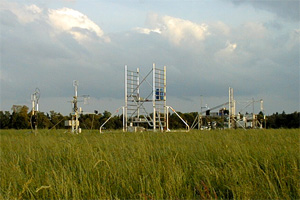
The gradient technique consists of multiple height continuous measurements, coupled with measurements of turbulence parameters. Fluxes are then calculated based on concentration differences between each height and the prevailing meteorological conditions. This technique has several limitations. Firstly as measurements are at different heights, each measurement has a different fetch (surface area which influences air sampled). This is especially important if there are significant variations in the nature of the fetch for each measurement. Secondly when attempting to measure fluxes of highly reactive species such as molecular iodine, chemistry occurring as air is transported to the different measurement points will affect measurements of turbulent flux. The REA technique overcomes both these limitations with its single height measurement.
Chamber Measurements
Chambers are used to directly measure emission or deposition rates over a small surface area for short periods of time by enclosing a small volume of atmosphere in contact with the surface and measuring how concentrations of species of interest vary with time. This technique is very useful for determining emissions from different types of surface or species of vegetation in isolation, whereas other flux techniques will generally average over a large area consisting of a variety of surface types or species of vegetation. Care must be taken that the presence of the chamber itself does not influence the emission rate, for example by altering the amount of sunlight or precipitation reaching the surface, or allowing concentrations within the chamber to vary from the surrounding air to such an extent that further emission or deposition is inhibited. To avoid these problems chambers are generally opened and closed at regular intervals only isolating the enclosed area for short periods of time, and additionally are often moved from site to site to allow enclosed areas time to recover.
Development work with chamber systems has included design and construction of multiple chamber systems, with an autonomous control and data acquisition system to automatically control opening and closing of several chambers, sampling air only from the closed chambers. This system is able to operate without operator attention for extended periods of time, and has been used to study NOx emissions from forest floors.
